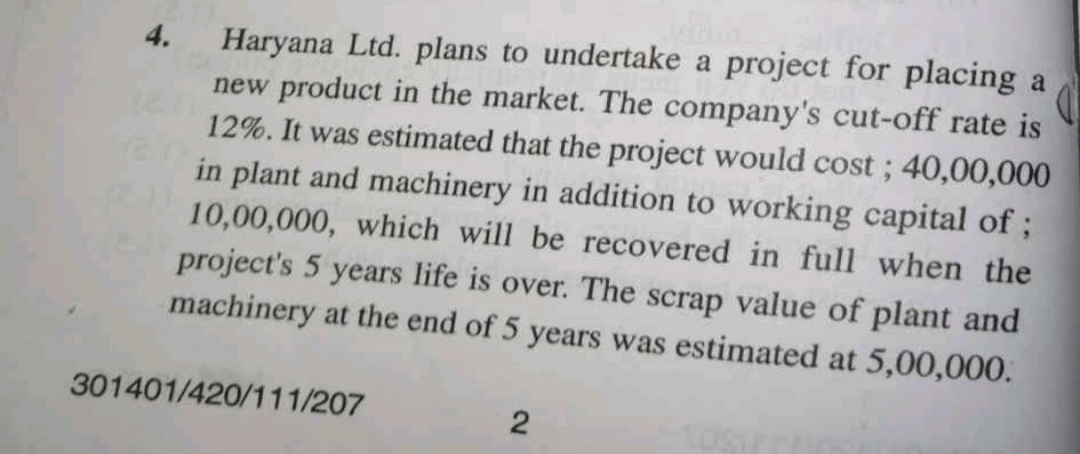Haryana Ltd. plans to undertake a project for placing a new product in the market. The company's cut-off rate is 12%. It was estimated that the project would cost 40,00,000 in plan... Haryana Ltd. plans to undertake a project for placing a new product in the market. The company's cut-off rate is 12%. It was estimated that the project would cost 40,00,000 in plant and machinery in addition to working capital of 10,00,000, which will be recovered in full when the project's 5 years life is over. The scrap value of plant and machinery at the end of 5 years was estimated at 5,00,000.

Understand the Problem
The question provides details about a project undertaken by Haryana Ltd. and mentions costs related to plant and machinery, working capital, and the project's lifespan. It requires an analysis of these details, possibly to calculate net present value or other financial metrics related to the project.
Answer
The Net Present Value (NPV) of the project is approximately $-41,50,427.83$.
Answer for screen readers
The Net Present Value (NPV) of the project is approximately $-41,50,427.83$.
Steps to Solve
-
Identify Total Initial Investment
The total initial investment includes the cost of plant and machinery and the working capital.
Total investment = Cost of plant and machinery + Working capital
$$ \text{Total Investment} = 40,00,000 + 10,00,000 = 50,00,000 $$
-
Calculate Cash Flows for the Project's Life
At the end of the project's 5 years, there are two cash inflows: the recovery of working capital and the scrap value of machinery.
Total cash inflow at the end of year 5 = Recovery of working capital + Scrap value
$$ \text{Total Cash Inflow} = 10,00,000 + 5,00,000 = 15,00,000 $$
-
Determine the Present Value of Cash Flows
The present value (PV) of the cash inflows at the end of 5 years needs to be discounting it at the company's cut-off rate (12%).
The formula for present value is given by:
$$ PV = \frac{C}{(1+r)^n} $$
Where:
- ( C ) = cash inflow at year 5
- ( r ) = discount rate (12% or 0.12)
- ( n ) = number of years (5)
Therefore, substituting in the values:
$$ PV = \frac{15,00,000}{(1 + 0.12)^5} $$
-
Calculate the Net Present Value (NPV)
Using the PV calculated in the previous step, the NPV of the project is given by:
$$ NPV = PV - \text{Total Investment} $$
Substitute in the total investment we found earlier and the present value.
-
Calculate the Present Value Using the Formula
First, calculate $(1 + 0.12)^5$:
$$ (1 + 0.12)^5 \approx 1.7616 $$
Now calculate PV:
$$ PV \approx \frac{15,00,000}{1.7616} \approx 8,49,572.17 $$
-
Final Calculation of NPV
Now that we have the PV:
$$ NPV = 8,49,572.17 - 50,00,000 \approx -41,50,427.83 $$
The Net Present Value (NPV) of the project is approximately $-41,50,427.83$.
More Information
A negative NPV indicates that the project is not expected to generate sufficient returns to cover its costs based on the company's cut-off rate of 12%. This suggests that the project may not be a financially viable investment for Haryana Ltd.
Tips
- Ignoring Working Capital Recovery: Failing to consider that working capital is recovered at the end of the project lifespan.
- Incorrect Discounting: Miscalculating the present value by not following the formula or the powers of $(1 + r)$.
- Overlooking Scrap Value: Forgetting to include the scrap value when calculating cash inflows for year 5.
AI-generated content may contain errors. Please verify critical information